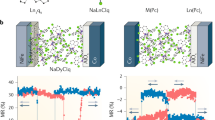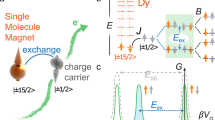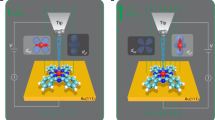Abstract
The ability to manipulate electron spin in organic molecular materials offers a new and extremely tantalizing route towards spin electronics, both from fundamental and technological points of view. This is mainly due to the unquestionable advantage of weak spin–orbit and hyperfine interactions in organic molecules, which leads to the possibility of preserving spin-coherence over times and distances much longer than in conventional metals or semiconductors. Here we demonstrate theoretically that organic spin valves, obtained by sandwiching an organic molecule between magnetic contacts, can show a large bias-dependent magnetoresistance and that this can be engineered by an appropriate choice of molecules and anchoring groups. Our results, obtained through a combination of state-of-the-art non-equilibrium transport methods and density functional theory, show that although the magnitude of the effect varies with the details of the molecule, large magnetoresistance can be found both in the tunnelling and the metallic limit.
This is a preview of subscription content, access via your institution
Access options
Subscribe to this journal
Receive 12 print issues and online access
$259.00 per year
only $21.58 per issue
Buy this article
- Purchase on Springer Link
- Instant access to full article PDF
Prices may be subject to local taxes which are calculated during checkout





Similar content being viewed by others
References
Wolf, S. A. et al. Spintronics: a spin-based electronics vision for the future. Science 294, 1488–1495 (2001).
Tsukagoshi, K., Alphenaar, B. W. & Ago, H. Coherent transport of electron spin in a ferromagnetically contacted carbon nanotube. Nature 401, 572–574 (1999).
Ouyang, M. & Awschalom, D. D. Coherent spin transfer between molecularly bridged quantum dots. Science 301, 1074–1078 (2003).
Xiong, Z. H., Wu, D., Valy Vardeny, Z. & Shi, J. Giant magnetoresistance in organic spin-valves. Nature 427, 821–824 (2004).
Dediu, V., Murgia, M., Matacotta, F. C., Taliani, C. & Barbanera, S. Room temperature spin polarized injection in organic semiconductor. Solid State Commun. 122, 181–184 (2002).
Petta, J. R., Slater, S. K. & Ralph, D. C. Spin-dependent transport in molecular tunnel junctions. Phys. Rev. Lett. 93, 136601 (2004).
Pati, R., Sanapati, L., Ajayan, P. M. & Nayak, K. First-principles calculations of spin-polarized electron transport in a molecular wire: molecular spin valve. Phys. Rev. B 68, 100407(R) (2003).
Emberly, E. G. & Kirczenow, G. Molecular spintronics: spin-dependent electron transport in molecular wires. Chem. Phys. 281, 311–324 (2002).
Kim, G.-H. & Kim, T.-S. Electronic transport in single-molecule magnets on metallic surfaces. Phys. Rev. Lett. 92, 137203 (2004).
De Teresa, J. M. et al. Inverse tunnel magnetoresistance in Co/SrTiO3/La0.7Sr0.3MnO3: new ideas on spin-polarized tunnelling. Phys. Rev. Lett. 82, 4288–4291 (1999).
Soler, J. M. et al. The SIESTA method for ab initio order-N materials simulation. J. Phys. Condens. Matter 14, 2745–2779 (2002).
Mullins, D. R. et al. The adsorption site and orientation of CH3S and sulfur on Ni(001) using angle-resolved X-ray photoelectron spectroscopy. Surf. Sci. 372, 193–201 (1997).
Datta, S. Electronic Transport in Mesoscopic Systems (Cambridge Univ. Press, Cambridge, 1995).
Caroli, C., Combescot, R., Nozieres, P. & Saint-Janes, D. A direct calculation of the tunneling current: IV. Electron–phonon interaction effects. J. Phys. C 5, 21–42 (1972).
Ferrer, J., Martín-Rodero, A. & Flores, F. Contact resistance in the scanning tunneling microscope at very small distances. Phys. Rev. B 38, 10113–10115 (1988).
Reily Rocha, A. & Sanvito, S. Asymmetric I–V characteristics and magnetoresistance in magnetic point contacts. Phys. Rev. B 70, 094406 (2004).
Sanvito, S., Lambert, C. J., Jefferson, J. H. & Bratkovsky, A. M. General Green's-function formalism for transport calculations with spd Hamiltonians and giant magnetoresistance in Co- and Ni-based magnetic multilayers. Phys. Rev. B 59, 11936–11948 (1999).
Tomfohr, J. K. & Sankey, O. F. Complex band structure, decay lengths, and Fermi level alignment in simple molecular electronic systems. Phys. Rev. B 65, 245105 (2002).
Di Ventra, M., Pantelides, S. T. & Lang, N. D. First-principles calculation of transport properties of a molecular device. Phys. Rev. Lett. 84, 979–982 (2000).
Brandbyge, M., Mozos, J.-L., Ordejón, P., Taylor, J. & Stokbro, K. Density-functional method for non-equilibrium electron transport. Phys. Rev. B 65, 165401 (2002).
Taylor, J., Guo, H. & Wang, J. Ab initio modeling of quantum transport properties of molecular electronic devices. Phys. Rev. B 63, 245407 (2001).
Acknowledgements
This work is sponsored by the Science Foundation of Ireland under the grant SFI02/IN1/I175, the UK EPSRC and the EU network MRTN-CT-2003-504574 RTNNANO. J.F. and V.M.G.S. thank the Spanish Ministerio de Educacíon y Ciencia for financial support (grants BFM2003-03156 and AP2000-4454). A.R.R. thanks Enterprise Ireland (grant EI-SC/2002/10) for financial support. Travel has been sponsored by the Royal Irish Academy under the International Exchanges Grant scheme. We thank J. H. Jefferson for discussions.
Author information
Authors and Affiliations
Corresponding author
Ethics declarations
Competing interests
The authors declare no competing financial interests.
Rights and permissions
About this article
Cite this article
Rocha, A., García-suárez, V., Bailey, S. et al. Towards molecular spintronics. Nature Mater 4, 335–339 (2005). https://doi.org/10.1038/nmat1349
Received:
Accepted:
Published:
Issue Date:
DOI: https://doi.org/10.1038/nmat1349
This article is cited by
-
Nanoscale molecular rectifiers
Nature Reviews Chemistry (2023)
-
Phonon-assisted nearly pure spin current in DNA molecular chains: a multifractal analysis
Scientific Reports (2023)
-
Magnetic molecules lose identity when connected to different combinations of magnetic metal electrodes in MTJ-based molecular spintronics devices (MTJMSD)
Scientific Reports (2023)
-
Molecular design for enhanced spin transport in molecular semiconductors
Nano Research (2023)
-
Easy axis anisotropy creating high contrast magnetic zones on magnetic tunnel junctions based molecular spintronics devices (MTJMSD)
Scientific Reports (2022)



